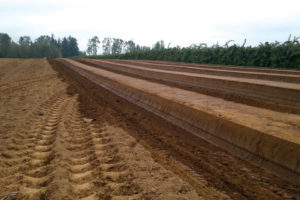New Pest Control Tool for Raspberry Growers
Root lesion nematode (Pratylenchus penetrans, RLN) is a migratory plant-parasitic nematode and is the primary reason red raspberry growers in Northwest Washington fumigate their fields.
RLN can be destructive if unmanaged due to feeding that reduces the raspberry root system and the plant’s subsequent ability to absorb water and nutrients. Methyl bromide is a powerful fumigant that raspberry growers once used to manage soilborne diseases and nematodes, including RLN. However, methyl bromide was phased out with the Montreal Protocol and growers have since struggled with effective RLN management.

Decision-aid tool for root lesion nematode management relies on research and understanding nematode biology in the raspberry system.
To develop tools and practices to promote RLN management for the raspberry industry, public and private researchers worked collaboratively with the raspberry and pest management industries in Washington State. After eight years of research, a decision-aid tool is now available that can help a grower with RLN management decisions with consideration to their site-specific conditions. This decision tool can be found here.
The first step to RLN management is deciding to replant a field and where to place the field. Most raspberry growers replant on ground that recently grew raspberries. Winter wheat is typically planted in the fall after removing a raspberry field and is terminated before spring planting, but further crop rotation is seldom practiced because of the lack of land available that is suitable for raspberry production. RLN also has a wide host range of approximately 350 plants, making crop rotation as a management practice difficult.
Next, a grower should sample the field and determine population densities. Soil texture is important when interpreting population densities and deciding on a pre-plant management strategy. Pre-plant fumigation is recommended if densities are greater than 15 and 45 RLN per 250 grams of soil in a sandy loam and silty loam soil, respectively.
First, Fumigate
Fumigation is currently the most effective way to manage RLN. The goal of fumigation is to reduce RLN populations and allow time for the plant to establish itself.
Fumigation efficacy will depend on the method of application and product used in a particular soil type. Research has shown deep shank application of Telone (DowDuPont) can be effective in heavier soils, such as sandy loams. In contrast, a shallow application (less than one 1 foot) of Vapam (AMVAC) is recommended for lighter soils like loamy sands. This is due to where RLN resides in these different soil types and to the movement of the fumigant at different application depths.

When preparing beds for raspberry planting, fumigation is the most effective way to manage root lesion nematode. (Photo: Lisa DeVetter)
Broadcast fumigation was once widely used to manage RLN, but research has shown bed fumigation is a more effective way to reduce RLN populations. Even though alleyways are not fumigated during bed fumigation, RLN has not been observed to move from alleyways into raised beds. Regardless of bed or broadcast fumigation, tarping will improve fumigant efficacy.
Nematicides may also be applied as a post-plant management tool to reduce RLN populations in newly planted fields. Vydate (DowDuPont) can be banded or drip-applied to non-bearing raspberry and has been shown to provide nematode suppression in fields with low nematode population densities. However, Vydate will not rescue a field with high nematode densities that was not or was poorly fumigated.
Fumigation Alternatives
Alternatives to chemical soil fumigation have been investigated. While solarization can be effective in certain production regions, raspberry growers in Northwest Washington are not able to consistently achieve temperatures that would effectively reduce RLN. New plastic technologies that increase heat transfer may enable effective solarization, but have not been studied in Northwest Washington raspberries.
Plant resistance or tolerance to pests and diseases is a valuable tool for growers, but unfortunately no such resistance or tolerance has been found in raspberries for RLN. Once planted, however, a grower can promote the success of their planting by engaging in good horticultural practices that promote plant health and establishment. Little research has been done on horticultural techniques to improve plant health and establishment to reduce the impacts of RLN parasitism.
Significant progress, information, and tools have been developed and growers now have more effective strategies to manage RLN in their fields. However, the fumigation landscape is continuously changing, driving the need for more research of viable practices that growers can implement in their fields to maintain productivity and on-farm profitability.









